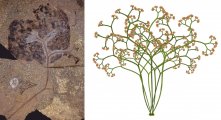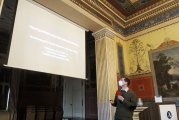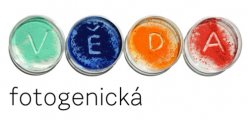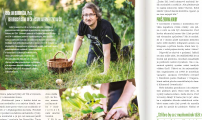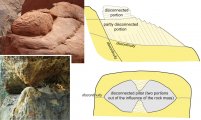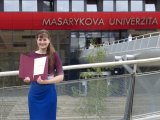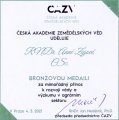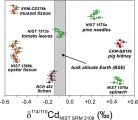News archive
News older than one year.
Tichavekia: a giant among the earliest land plants
A paper describing the terrestrial plant Tichavekia grandis was published in the Review of Palaeobotany and Palynology journal. It is co-authored by two members of the Institute of Geology, Monika Uhlířová and Jiří Bek. The plant lived in the Barrandian area (Czech Republic) some 420 million years ago. It was named after František Tichávek of the West Bohemian Museum in Plzeň, who had found the described specimen.
Award for a popular geology book
Miroslav Ivanov Award in the category “Regional history” was granted to our colleague Václav Cílek and co-editors Z. Sůvová and J. Turek for the book “The Land of Joachim Barrande – A Journey to the Prehistory of Bohemia”, published in 2020, by the Club of Factual Literature Authors and the town of Jaroměř–Josefov. Other geologists of the Institute of Geology – Radek Mikuláš, Jindřich Hladil and Petr Štorch – contributed to the book as co-authors. Congratulations!
Conference on planetary geology
Tomáš Kohout of the Institute of Geology CAS, who has been also long working for University of Helsinki, delivered a speech at the conference Cosmic Projects taking place within the Czech Space Week in Villa Lanna, Prague, on November 12, 2021. His contribution was related to mapping of the asteroid Didymos. The conference programme and individual presentations are published here; specifically, the talk of T. Kohout can be viewed by clicking here (starting from 42 min. of the recording).
Institute of Geology staff scoring in Photogenic Science competition
The Institute staff submitted a total of 24 photos for the present competition rund, of which 11 passed to the semifinals. This may be the reason why was the Institute granted the Special Award for the most attractive photographic performance. Moreover, several photographs were ranked high in two categories: 1st and 3rd position in the category of Muse in Science; 1st and 3rd position in the category Scientists and Household Chores. The awarded employees were Lenka and Pavel Lisý and Michal Filippi. The photos and information about the competition are available on the Photogenic Science website.
Czech–Chinese research of fossil tropical vegetational “Pompeii”, Inner Mongolia, China
Respected scientific international journal Review of Palaeobotany and Palynology dedicated a special issue (Vol. 294) to important results of the international team of Czech and Chinese palaeobotanists and palynologists at the Wuda locality, Inner Mongolia, China. The international team collaborated on six excavations (2011–2018) of a tropical forest 298 Myr old. Two members of the Laboratory of Palaeobiology and Palaeocology, Jiří Bek and Jana Votočková-Frojdová are co-authors of nine papers from this special volume describing important finds of fossil lycophytes, sphenophytes and ferns as they have been buried by volcanic ash after a huge volcanic eruption like in the legendary Roman city of Pompeii.
Scientists of the Institute contributing to Czech Acad Sci press
The last issue of the science-promotion magazine A/Science and Research, published by the Czech Academy of Sciences, presented interesting articles on mushrooms – a highly topical subject in autumn time. The texts were significantly contributed by our colleague Jan Borovička. The same issue also contains a brief comment by Michal Filippi on the article dealing with “invisible gold”, which raised interest among journalists worldwide recently.
A new style of sandstone disintegration documented
A recent paper in Geomorphology was also contributed by Michal Filippi of the Institute of Geology. It presents a newly recognized weathering style of sandstone outcrops. Its essence lies in a disconnection of smaller parts of rock along lithological and other discontinuities, which allows the material to dilate and damage the protective bio-crust on the cliff face. This results in a more effective function of erosion factors in the disconnected parts and their accelerated disintegration.
The Deanʾs Award
Hedvika Weinerová was awarded the Deanʾs Award for best students in the Doctoral programme for the year 2021. Her study at the Faculty of Science of Masaryk University is focused on changes in the composition of carbonate sediments of the Barrandian area with respect to Devonian bioevents and sea-level changes. For additional information click here.
An award for a GLI scientist
Anna Žigová was awarded the Bronze medal of the Czech Academy of Agricultural Sciences on 4 March 2021. This medal was awarded for an exceptional contribution to the development of science and research in the field of agriculture. For additional information click here. Congratulations!
Progress in the study of cadmium
Cadmium (Cd) is a toxic metal widely occurring in the environment, often due to the human activity. The employees of the Institute of Geology of the Czech Acad Sci have developed a method for measuring Cd isotopes in biological samples using thermal ionization mass spectroscopy (TIMS). The results published in the prestigious analytical journal Talanta represent a useful tool in the quality control of chemical analyses for all laboratories involved in the analysis of cadmium in biogenic materials. Find out more here or in the original publication.


